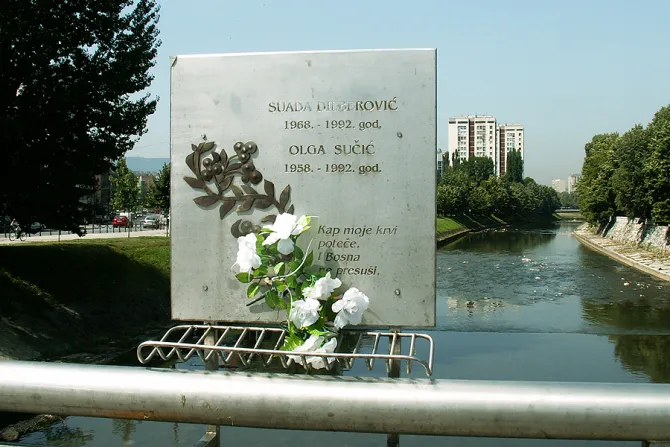Sarajevo, Bosnia and Herzegovina, Jun 5, 2015 / 16:12 pm
When Pope Francis visits Bosnia and Herzegovina tomorrow, he will be visiting a country still devastated by the three-year Bosnian War that took place in the early 1990s.
An estimated 100,000 people were killed in the conflict. Twenty years later, reminders of the violence are everywhere – even the route that Pope Francis will take from the Sarajevo international airport to the presidential palace is known as "Aleja snajpera," or Sniper Alley, due to the violence of previous years.
During the Yugoslav Wars, which include the Bosnian War and several surrounding conflicts, snipers killed at least 600 people – including some 225 children – and injured more than 1000 people.
Among them were the "Romeo and Juliet of Sarajevo," – Bosko Brkic, a Serbian, and Admira Ismic, a young Bosnian Muslim girl. Their story is well known in the area. The two fell in love despite the war and the fact they were trapped under the siege of Sarajevo, which lasted about four years.
"At one point, they made the decision to leave Sarajevo, to pursue their lives somewhere else. Bosko prepared all the documents, and they were ready to go to the airport, and to be finally free to live their love," Daniele Bombardi, who works with Caritas in Bosnia, told CNA June 5.
Before fleeing to the airport, the couple had to cross Vrbanja Bridge, which connects the Muslim part of Sarajevo – where the two were living at Admira's parents' house – to the Serbian bloc Grbavica, where they would say goodbye to Bosko's parents before leaving.
Bombardi recounted that "Vrbanja Bridge was particularly dangerous, because it was under the target of snipers."
Two students – Suada Dilibegovic and Olga Sucic – had previously been killed at this bridge by a sniper in 1992: they were the first civilian victims of war. A year later, a pacifist was killed at the same spot while placing flowers at the site of their death.
Still, Bosko and Admira tried to run across the bridge, making their attempt in May of 1993.
"At the middle of the bridge, Bosko was shot dead by a sniper. He was struck in the head, and he immediately died. Admira was also shot, but did not immediately die. With her very last breath, she reached toward the corpse of her boyfriend and embraced him," Bombardi said.
The two lay dead in each other's arms on the bridge for eight days, before a truce was agreed upon and the corpses were removed. They have since been buried in a common grave under a simple cross at the Cemetery of the Lion in Sarajevo.
Bombardi explained the significance of the location: "In front of the cemetery, there is the café where the two lovers met and spent most of their time during the war."
An international documentary about Bosko and Admira was released in 1994. Their grave stands today as a sharp reminder of the pain that remains in the country two decades later.



